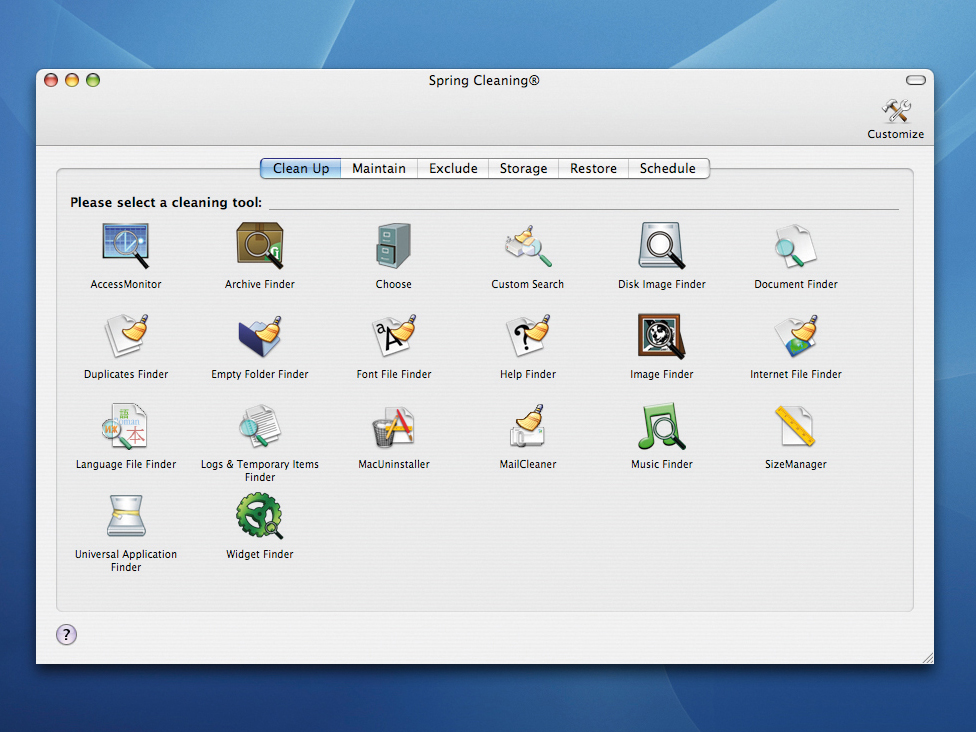TechRadar Verdict
Useful for sweeping out old redundant files and getting a snapshot of your system
Pros
- +
New scheduling tool
Easy to use
Trim your Mac
Cons
- -
Prone to crashing
Sluggish searches
Be careful what you delete
Why you can trust TechRadar
Spring Cleaning is a chocolate box of different system administration tools for tidying up your Mac OS. Each year its panels get a new graphical interface and a few more tools are added.
Included in the 9.0 bundle are 20 small applications for searching out files. These are all located under the Clean Up tab in the main window and offer quite a range of options. A further handful of maintenance tools, including a useful new addition called Housekeeping Scripts Runner, and a separate Task Scheduler are in the package, too.
Searching for files
You can search for files by size, by type, by association with other applications or by when they were last accessed, among other options. Each search is customisable. You can apply filters and rules to searches before you run them, too.
When the results come back you get options of what to do with the files. First you select the files you want to action and then choose from a drop-down menu of actions to be applied. We went hunting for files to clean off the system and free up space, so we used the Move to Trash action more often than not.
After the system was free of duplicates, empty folders and files that weren't likely to ever be used - like foreign language help files for example - we then ran searches for files that were in the wrong place, like music files that should be in our iTunes Library but had been lazily imported to the Mac and ended up in a Desktop folder.
We also cleaned out old caches, and unwanted temporary files, which seems a good point to inject a word of warning; be sure of what you are deleting. Often searches returned required system files that innocently matched the search criteria, and to the untrained eye, or person who rushes to delete, these might be removed in error.
There is nothing startlingly original about performing these tasks in the OS, but it's nice to able to do so from inside one application. With a bit more elbow grease you could do the same using Finder, your Trash can and a mouse - but it would take considerably longer and you would miss any files with exotic extension names that you can't remember.
New tools
There are four new tools in version 9.0. Among them, we found that Task Scheduler was the most useful for us. You use it to set a work plan in place for the other tools to follow. This means you can have regular maintenance tasks happening without your supervision. Permissions Fixer is another new arrival, but it works in exactly the same way as Mac OS X's own Disk Utility - verifying and fixing permissions. We prefer Disk Utility because you get more detailed results.
Launch Services Rebuilder is another new tool, and one that's supposed to pair orphaned program files with applications that can open them. This failed to pair orphaned InDesign files with the program in our test; the OS still prompted us to choose an application to run the files when clicked open.
The final newbie is Housekeeping Scripts Runner, which simply runs Mac OS X's automatic maintenance scripts whenever you like. The OS usually runs these scripts at night when you are sleeping, but as most of us turn our Macs off, it's useful to have this new flexibility.
The real problem that Spring Cleaning faces is the proliferation of cheap or free shareware applications that can do the same job. Then you have the free utility tools in the Mac OS that can perform the same tasks too. Just look in your Utilities folder to find them.
The value of Spring Cleaning is not about doing anything unique but that it lets you do everything from one application, which at the very least saves you hours of hunting down and testing out all the individual shareware releases on versiontracker.com. For those with patience, try FreeSpace, CleanApp, AppZapper, Chaos Antidote, Tidy Up, Doublet Scan... and the rest.
Tech.co.uk was the former name of TechRadar.com. Its staff were at the forefront of the digital publishing revolution, and spearheaded the move to bring consumer technology journalism to its natural home – online. Many of the current TechRadar staff started life a Tech.co.uk staff writer, covering everything from the emerging smartphone market to the evolving market of personal computers. Think of it as the building blocks of the TechRadar you love today.
